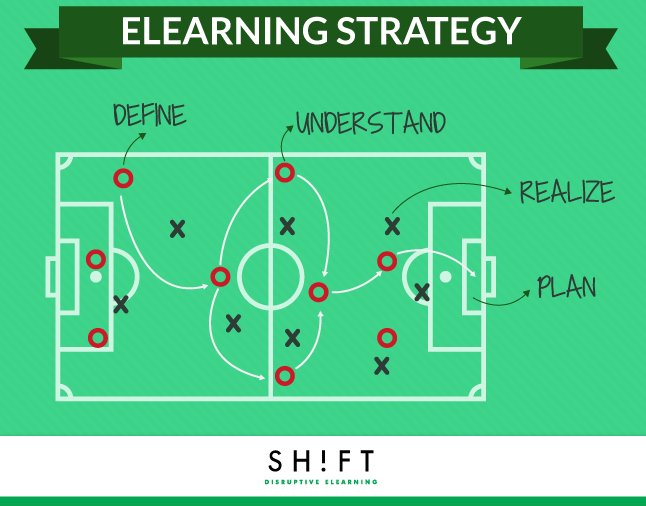When it comes to eLearning, every course will be unique. Hence, the purpose of your efforts needs to be defined before you begin to plan and develop the course required to meet that end. This is done by creating an overall strategy for the eLearning project.

You can create a winning eLearning strategy simply! Start by answering these important questions:
Define — Purpose, Scope, and Goals of eLearning
What do you want to achieve with eLearning?
The questions to ask include: What will your organization accomplish with eLearning? Why is it needed? How will it help the organization or your client meet their business goals?
You must assess the need for the training you are developing and prioritize the needs. Divide the training into categories. Start with the fundamentals, asking: is it mandatory or nice-to have? Begin with the bare minimum, the absolutely necessary and essential parts of the training and define the scope based on those fundamentals. Decide its focus: will it focus on a single topic/skill or impart a more generalized form of content for the audience? Leave the rest for planning in the long term.
What are your goals?
eLearning is a change initiative and requires long-term planning for implementation and integration into the organizational culture. Embarking on eLearning without a clear understanding of your goals is a surefire way to fail. Hence, your eLearning strategy must have both short-term and long-term goals.
Your eLearning must directly impact the organizational goals. To do so, you must create a list of specific and measureable objectives that you want to achieve with the implementation of your eLearning course.
Although the first goal of the courses should be to assist learners in gaining new, advanced skills they can easily incorporate into their current roles, however, the organizational needs may extend beyond learning, including:
- Reducing time to completion — Flexible timings (increased mobility and accessibility via internet).
- Improving training development time and costs — eLearning can reduce the time and the costs needed to create a course relative to traditional classroom training.
- Reduced training costs due to ease of creating, updating, and reusing content.
Understand — Audience and Organizational Readiness
Who is your target audience, what do they want?
Understand your audience: their current knowledge, their abilities, job roles, and what need do they have for your eLearning content. Research and define the ideal target audience in terms of their expectations of eLearning, IT literacy levels, tech-savvy, grasp of mobile learning, and the training provisions you currently have.
By understanding your audience, your eLearning becomes learner driven, establishing successful eLearning environments where the needs of the learners are answered. Consequently, the training becomes more engaging and useful.
What is the current technical status?
eLearning relies on availability of technology for its delivery. Hence, you must assess the IT readiness of the organization. Ask: do they have the right IT platforms? Is the technology for implementing a scalable eLearning training program available? What changes are needed in the current IT environment, and will the current eLearning courses integrate with the future changes?
The bare minimum is the availability of a computer with reliable Internet connectivity. However, you must address employee mobility in your strategy so that the content can easily be scaled when organization wide mobilization is implemented.
You have to develop a strategy to align these changes.
Realize — Stakeholders, Buy-in Process, and Limitations
Who would be involved?
The biggest problem with implementing an eLearning strategy is to get the say from the stakeholders — and these can be varied and dispersed across the organization. Finding them and understanding their concerns is crucial for the buy-in process.
What are the inhibitors and limiters to learning implementation?
What are the risks associated with your strategy? Which issues can sabotage the schedule and the timeline, and perhaps the overall integrity of the eLearning strategy?
Profile the risks, individually qualify and prioritize them, and build the right answers.
Plan — Access, Marketing, and Measurement
How will courses be accessed?
Your interactive elements will be designed according to the network on which the course will be accessed. Will it be an LMS, mobile devices, or the company’s intranet?
How would you market the program?
Marketing should be part and parcel of your rollout plan, and clearly defined in the strategy. This makes it easier to design programs so that they can easily be promoted. Your end goal is to engage the target audience, and how it should be done should start with the first slide or course you intend to make.
Check some ideas for marketing your eLearning programs.
How would you measure results?
Finally, which results are important and how will they be identified and measured? Important KPIs include performance, ROI, and cost of owning the eLearning training. The best way to find the right KPIs is to involve the management team and other stakeholders.
Here are some tips for measuring training results.








